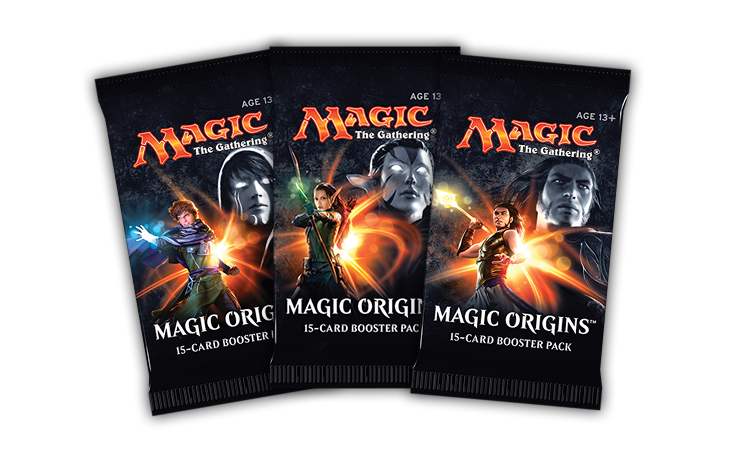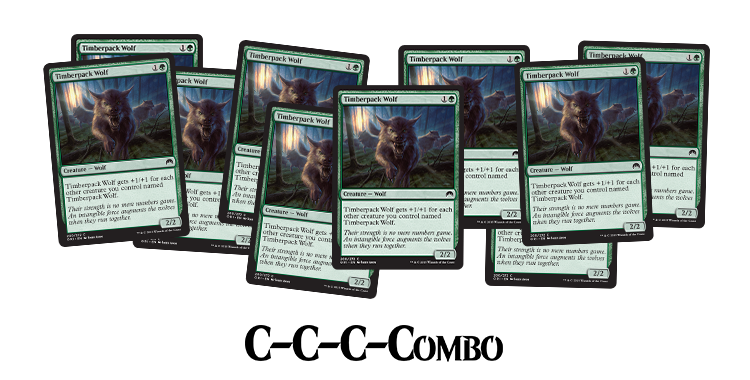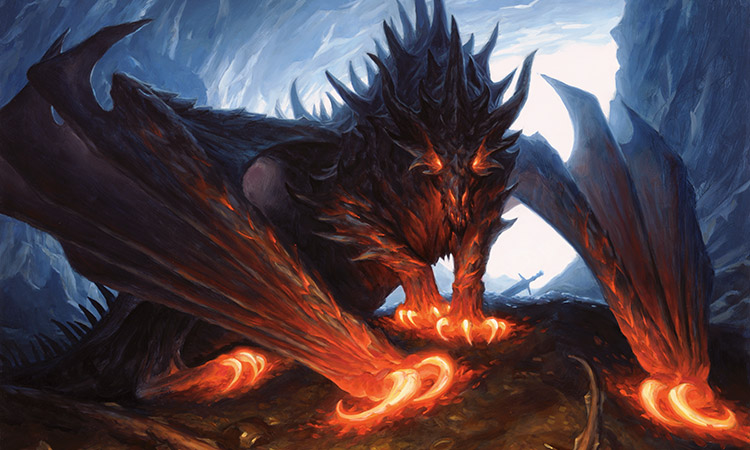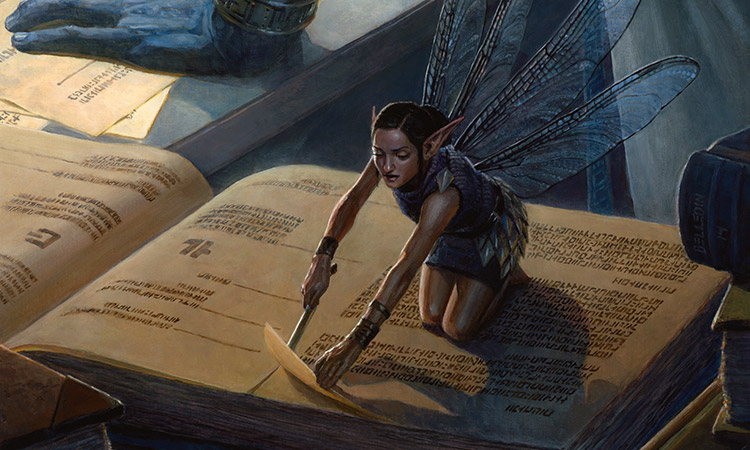The Basics of Booster Draft
For the next few weeks, Reid is revisiting some of the key concepts of Magic, updated for Magic Origins. These concepts are so important to learning Magic that we wanted to reintroduce them to the next wave of Magic players. Enjoy.
Booster Draft is one of the most played Magic formats among casual players, as well as at every level of competition. Together with Sealed Deck, it's the Limited format of choice for most tournaments, including Pro Tours, Preliminary Pro Tour Qualifiers, and Grand Prix. It's popular among occasional players who want to avoid the pressures of maintaining a collection and a Constructed deck. On the other hand, it's equally popular among serious players who enjoy the depth and challenge of the format. Learning Booster Draft should be a priority for any aspiring Magic player.
Booster Draft (or just "Draft") is like Sealed Deck, with the additional primary step of drafting the cards. The players—usually eight sitting in a circle—each open a booster pack, pick one card, and pass the pack to the next player, who picks one card and continues to pass it along. Eventually, all of the cards are picked and the players repeat the process with a total of three booster packs. At the end of a Magic Origins draft, players will have 42 cards (not counting basic lands) with which to build a 40-card deck. Just like Sealed Deck, players may add any number of basic lands to their deck.
DRAFTING A DECK
In Sealed Deck you open six packs and in Booster Draft you only open three. Nevertheless, the total number of cards that you see in a draft is much higher than in Sealed Deck. Since you have the flexibility of choosing which cards you think will be best for your deck, in a way, your total pool of cards is much larger in a draft than it is in Sealed Deck.

This means that you can expect Draft decks to be slightly better, more powerful, faster, and (most importantly) more focused than in Sealed Deck. You can choose all of your cards to work toward one concerted strategy. Things will never be as extreme as Constructed, but your Draft decks might fit the mold of an aggro deck or a control deck depending on the choices you make.
Synergy
Synergy is an important concept for every format in Magic. In particular, though, it should be at the front of your mind during a draft, as it can guide you in the direction of good picks and an effective deck. Synergy means cards working especially well together.
Synergy can exist between two cards (sometimes called a combo), like in the case where Act of Treason lets you sacrifice your opponent's creature to a Nantuko Husk. A single card can have synergy with the rest of your deck—say Shaman of the Pack in a deck with lots of Elves. Or, perhaps the best case of all is that synergy is built into your deck on the whole. Let's say your deck features a lot of cheap creatures with renown and a lot of combat tricks to help you keep attacking. In this case, your deck has a clear plan and all of your cards are working toward this plan. Your combat tricks will help you force through your renown creatures, and all of your cheap creatures will give you ample opportunities to use your combat tricks effectively.

Photo courtesy Christian Calcano, Grand Prix Dallas/Fort Worth
Archetypes
An archetype is a recurring strategy with numerous possible variations. The shell or pattern of an archetype remains recognizable despite individual cards changing. Archetypes exist in Constructed—you can build two functionally similar control decks even in formats where different sets are legal—and they also exist in Booster Draft.
An example of an archetype, in the context of Magic Origins draft, is a Blue-Red Artifacts deck. Ghirapur Gearcrafter is a card that goes perfectly in a Blue-Red Artifacts deck, but you can still build a Blue-Red Artifacts deck without it. The same is true of Artificer's Epiphany, Chief of the Foundry, Whirler Rogue, and so on. The recognizable traits of every Blue-Red Artifacts deck will be flying creatures, removal spells, card advantage, and taking advantage of artifact synergies. If you do a good job drafting Blue-Red Artifacts, these features will exist no matter what individual cards you wind up with.
In a perfect world, you would start a booster draft with one or more archetypes in mind. Having a vision for the way you want your deck to end up is extremely helpful. Moreover, like always, practice makes perfect. The first time you draft Blue-Red Artifacts or Black-Red Sacrifice, you might—to some extent—be muddling your way through. However, once you've drafted an archetype five or six times, you'll begin to learn its strengths and common pitfalls, and be able to draft accordingly.
Balance
A desire for synergy, or to draft a particular archetype, should never overshadow the basic principles of Magic. As always, foremost in your mind as you draft should be your mana base, mana curve, creature count, removal spells, and card advantage.
A well-built deck with a smooth mana curve and a good mix of creatures and spells will function just fine, even if it doesn't have much synergy. A deck that has a lot of synergy but a bad mana base and a bad mana curve will still be clunky and awkward. Synergy is good, but it should not come at the expense of what's most important!
Remember also that all cards are not created equal. Avaricious Dragon might not have any special synergy with a Blue-Red Artifacts deck. However, you'd better believe that I'm picking Avaricious Dragon over Ghirapur Gearcrafter, Artificer's Epiphany, or virtually any other card you can imagine! After all, this is still Limited Magic and a bomb is a bomb!
CHOOSING YOUR COLORS
One of the most interesting questions in Booster Draft is how to choose your colors.
The most basic strategy is simply to choose your colors ahead of time, before you even open your packs. This is a completely valid strategy that I often recommend as best for beginners. There's no shame in it! In fact, if you were to employ this strategy at higher levels of competition, so long as you did a good job drafting, building your deck, and playing the games, you'd have a perfectly fine chance to do well.
Just remember that it's illegal to coordinate with the drafters sitting next to you by telling them what colors you intend to draft or asking them what colors they intend to draft.
A very slightly more advanced strategy is to draft the best cards out of your first couple of packs, regardless of what color they are. Then, you just draft whatever colors your first couple of picks were! This way, you get the potential benefit of opening a premium card in any color but don't have to worry about wavering between colors. You won't waste any picks on cards of a color that doesn't wind up in your deck.
Advanced drafters, however, will be adaptable and let what happens in the draft determine what colors they choose. Sometimes, they won't completely decide their colors until halfway through the draft! They value the ability to stay open.
Staying open means looking for opportunities. For example, let's say you open Avaricious Dragon in pack two. In the case where you've decided your colors right away, it's completely up to chance whether or not you'll be able to put it in your deck. In the case where you've stayed open, you'll be able to jump on the opportunity of opening a bomb card and playing with that color.
Even more important is the ability to find an open color. Now let's say that I'm the one who opens the Avaricious Dragon instead of you. I'd decided early in the draft that I was going to draft white-green, and so I pass the Dragon right along to you. If you're able to correctly identify that I'm not drafting red, then you have the ability to get that Dragon along with every other good red card that I'm going to pass you over the course of the draft.

Avaricious Dragon | Art by Chris Rahn
WHAT THE OTHER DRAFTERS ARE DOING
What makes Booster Draft so interesting is that it's a dynamic process with lots of moving parts. What you do affects the drafters around you and what they do, in turn, affects you.
Although they'll eventually be your opponents in the tournament, ideally you wouldn't fight for colors with the drafters next to you, because doing so would wind up making both of your decks worse. If you somehow knew for a fact that the players on either side of you were drafting blue-red and black-red decks, it would probably be in your best interest to draft white-green, because you'd get passed all of the best white and green cards that your neighbors didn't want.
Signals
When neighboring drafters learn what one another are drafting, they're able to cooperate and will both wind up with better decks. This type of understanding and cooperation can be accomplished through signaling.
Signaling doesn't mean winking, shaking your leg under the table, or tipping your baseball cap three times. It certainly doesn't mean talking about the draft as it's happening. All of these things are strictly illegal. Instead, signaling comes in the form of what cards you pass, receive, do not pass, and do not receive from your neighbors.
The best example of a signal is receiving a very strong card late in the draft. Fiery Impulse, for example, is a premium card that any red drafter would love to add to his or her deck. To see a Fiery Impulse pick six means that the five players passing to you all declined to pick it. For each of these five players, it probably means one of two things. Either (A) they picked a stronger red card (perhaps possible for the player who opened the pack if there was a bomb rare) or (B) they aren't drafting red (more accurate is to say that they weren't drafting red at the time they made the pick).
Seeing a late Fiery Impulse is a signal that red might be an open color. This means that if you draft red, you have a slightly higher chance of being passed strong cards as the draft progresses, since your neighbors will be less interested in them. Likewise, passing a Fiery Impulse sends a signal downstream that red might be an open color. If you pass a Fiery Impulse, it shouldn't come as a great surprise if you later find out that a player you were passing to drafted red.
Signaling is a complicated concept, and I won't go much deeper on the subject today. (For further reading, check out my article on Signals in Booster Draft.) For now, let me leave you with the advice that you should simply try your best to be aware of what's going on around you in a draft. Note what strong cards are being passed to you and if any color is noticeably missing. That said, you also shouldn't go crazy trying to adapt your draft to signals. Sometimes, by the time you know what your neighbors are drafting, it's so late that all the best cards are already gone anyway! The more you switch colors, the more picks you waste and the lower the chances of piecing together an effective deck.
Choose your colors and archetype based on a combination of three factors: what you want to draft, what cards you've already drafted, and what you think might be open. The weights you put on these three factors will change based on the circumstances and as the draft progresses. Generally speaking, though, I don't think that any one is more important than the other two.
Counterdrafting
Do not counterdraft!
I'm hesitant to mention counterdrafting in Level One because it's a relatively unimportant aspect of Booster Draft. However, I do so in the hope that I can help my readers avoid a common pitfall of beginning drafters, which is that once they learn the concept of counterdrafting, they put far too much emphasis on it.
To counterdraft means to spend a pick simply taking a card out of the draft, so no one else can have it. Return to the example where I'm drafting white-green and I open Avaricious Dragon. If I were to pick it, not with the intention of putting it in my deck, but simply so that you won't get it, then I'm counterdrafting.

Faerie Miscreant | Art by Steven Belledin
Counterdrafting isn't mean or unsportsmanlike; it's simply a strategic decision that's part of the game. The problem is that it's typically a bad strategic decision. In an eight-player booster draft, you have seven potential opponents and should be thinking about how your deck will stack up relative to theirs. A positive addition to your own deck has a relatively great impact. Hurting one of your seven opponents' decks won't greatly increase your chances of winning any given round.
For me to regret passing you the Avaricious Dragon, here's what has to happen: First, we have to get paired (typically, you play against three of your seven opponents). Second, you have to draw your Dragon. Third, you have to beat me in a game and match because you had it instead of whatever the next-best card would've been. This is possible, but it's not particularly likely.
It's correct for me to counterdraft the Avaricious Dragon if and only if there's nothing I want from the pack. Prioritize your own deck first, and make counterdrafting only an afterthought. If there's a time for counterdrafting, it's usually much later in the pack, once most of the good cards have dried up. Then, if there's nothing for you and a playable card for an opponent, you can feel free to snatch it up.
If you take one lesson from today's article it should be that Booster Draft is as hard as you want to make it. Concepts like signaling and counterdrafting are deep and complex, but the fundamentals are relatively easy. You can go far by just focusing on things like balance, mana curve, and card advantage. If you're new to the Magic, don't be scared to try out Booster Draft. If you're more experienced, then I challenge you to focus on a new aspect of the format that you haven't yet mastered!

